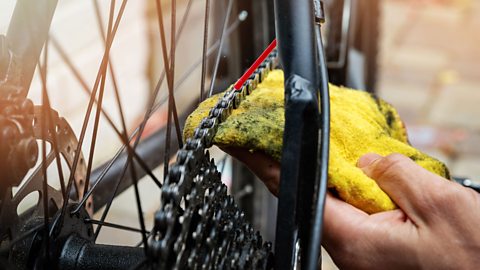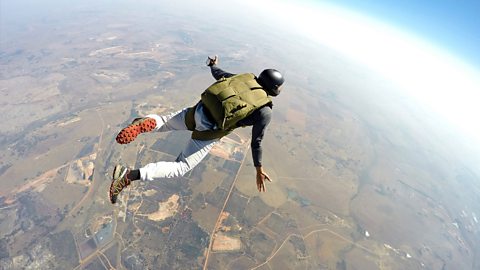Key Points
frictional forcesForces which resist an object moving. occur in many different situations.
Frictional forces stop us from slipping when we walk and slow down a cyclist when they stop pedalling.
Friction is a contact force and acts against the movement of an object.
What are frictional forces?

When an object is moving there are almost always forces which act against it, unless it is in a vacuum as in space. These are frictional forces and act in the opposite direction to the movement. Frictional forces make it more difficult for objects to move.

Friction

Friction is a contact force. It acts against the movement of an object.
There are many examples of where friction is a useful force. For example, friction is why we do not slip when we walk along the pavement. It is also useful in bikes and cars. Without friction, they would not be able to accelerate, turn or brake.
Friction can also be unhelpful. For example when the mechanical parts of a bike, like the chain and axles, rub together the friction can cause the metal to wear away.
Friction also causes objects to heat up. For example, rubbing hands together on a cold day to keep warm. The friction between the palms of your hands causes them to heat up. Friction between moving objects causes thermal energy to be dissipatedWhen energy spreads out into the surroundings and becomes less useful. out to the surroundings.
We can limit the amount of friction using LubricationApplying a slippery substance to two surfaces to reduce friction. Oil is a common lubricant which is applied to moving parts in machines, like the chain and gears on a bike.. Substances like motor oil can be used to stop metal parts from rubbing and wearing away.
Modern taps use moving parts made from a low friction plastic called PTFE, rather than rubber and brass.

Investigating friction
Investigate frictionA force which acts against the movement of an object. by comparing the amount of force needed to move an object on different types of surfaces by following these steps.
Step 1 - what are the three experimental variables?
independent variableThe factor which is deliberately changed in an investigation, to find out how it affects the dependent variable. - the type of surface
dependent variableThe outcome of an investigation which is measured. - the amount of force needed to move at a constant velocity
control variableFactor in an investigation which are not being investigated but which might affect the outcome (the dependent variable). The control variables are things which must be kept the same whilst the independent variable is changed. - the speed of the object and the mass of the object
Step 2 - carry out the experiment
Method
- Set up the equipment by attaching a newton metre to a mass.
Place your first surface type on the table or bench.
Pull the mass for a 30 cm distance across the surface at a constant speed. Measure the reading on the newton meter.
Return the mass back to the starting position and repeat a further 2 times.
Calculate a mean force.
Swap the surface type and repeat steps 3, 4 and 5.
Step 3 - how to make your experiment valid
You should always repeat your measurements three times.
You can then identify any anomalous resultA measurement which is very different from other measurements taken in the same situation, so it seems unusual and hard to explain. Anomalous results are usually ignored in an investigation (ie not included when calculating a mean average) or repeated to check them. and calculate a mean.
Step 4 - presenting and interpreting the data?
Calculate the mean force for each surface type.
Plot a bar chart of mean force against surface type. For example:
You should find that more force is needed to move an object over a surface where there is lots of friction.
Air resistance and drag

dragA force that acts on an object which is moving through a fluid (a liquid or gas) in the opposite direction to its movement, so its effect is to slow down the moving object.is the force which acts against the movement on an object when it moves through a fluid (a liquid or gas). The faster the object moves the more drag it experiences. When the fluid is air, drag is usually described as air resistanceA force that acts on an object which is moving through air. Air resistance acts in the opposite direction to the direction of movement, so it acts to slow down the moving object..
The effects of air resistance can be reduced by streamliningWhere the shape of an object causes little resistance in air or in water. the object, which will allow the moving object to go faster for the same thrustThe force which acts on a moving object to cause it to move. Thrust is often generated by an engine, for example in a car, rocket or aeroplane.force. Cycling teams and Formula 1 motor racing teams work to reduce the effects of air resistance. They design cars, helmets and bikes which are streamlined so that the cyclist or car can travel as quickly as possible.

Test your knowledge
Quiz - Multiple choice
Play the Atomic Labs game! gamePlay the Atomic Labs game!
Try out practical experiments in this KS3 science game.

More on Forces and movement
Find out more by working through a topic
- count8 of 16

- count9 of 16

- count10 of 16

- count11 of 16
